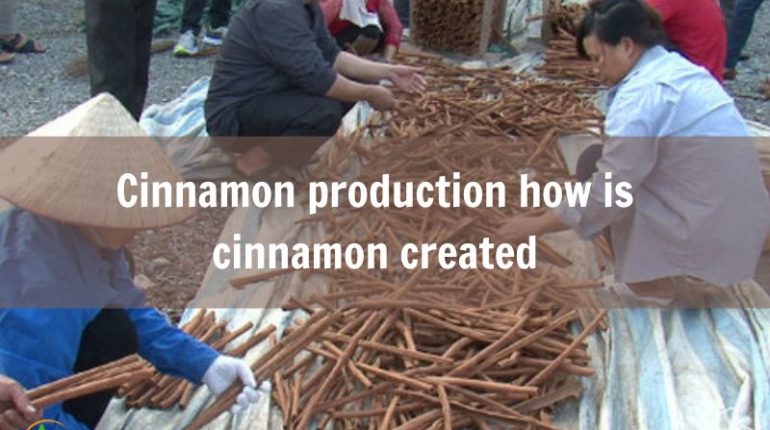Many individuals are interested in learning about cinnamon production and how cinnamon is created. This article will walk you through the steps of cinnamon manufacture.
1. An summary of cinnamon production in general
A basic understanding of cinnamon production is essential for anyone looking to conduct business in the cinnamon market.
1.1 Cinnamon production definition
Cinnamon, derived from the inner bark of Cinnamomum trees, undergoes an intricate process to transform into the familiar spice we know. The primary species used in cinnamon production include Cinnamomum verum (Ceylon cinnamon) and Cinnamomum cassia (Chinese cinnamon). The production process involves cultivating, harvesting, drying, and processing the bark into different grades and forms.

An summary of cinnamon production in general
1.2. Typical Cinnamon Product Types Of Cinnamon Production
When it comes to cinnamon, there are various product types available to cater to different culinary and commercial needs. Here are some typical cinnamon production types:
- Cinnamon Sticks: Cinnamon sticks, also known as cinnamon quills, are the most recognizable form of cinnamon. They are made by rolling and drying the cinnamon bark, resulting in long, slender sticks with a textured appearance. Cinnamon sticks are commonly used in cooking, baking, and as flavoring agents in beverages. Ceylon cinnamon sticks wholesale is one of the most popular.
- Ground Cinnamon: Ground cinnamon, often referred to as powder cinnamon, is made by finely grinding cinnamon sticks into a powder form. Ground cinnamon is convenient to use and widely used in baking, desserts, spice blends, and a variety of savory dishes. It provides a rich, warm flavor and is a staple in many cuisines around the world.
- Cinnamon Oil: Cinnamon extract is a concentrated form of cinnamon derived by extracting the active compounds from cinnamon bark or leaves. It is commonly used as a flavoring agent in food and beverages, such as candies, syrups, and flavored drinks. Cinnamon extract is known for its intense flavor and is used in smaller quantities compared to other cinnamon products.
1.3. Cinnamon production main distribution
Cinnamon production is primarily distributed in several countries, including Indonesia, Vietnam, and China. Let’s explore the main distribution of cinnamon in each of these countries:
- Indonesia: It is a major producer and exporter of cinnamon, with regions like Sumatra, Java, and Sulawesi being important cinnamon-growing areas. Indonesian cinnamon types include Cassia and Indonesian Korintje cinnamon, known for their strong and spicy flavors.
- Vietnam: The northern mountainous regions of Vietnam, including Yen Bai, Lao Cai, and Lang Son, are renowned for cinnamon cultivation. Cinnamon in Vietnam, also called Saigon cinnamon or Vietnamese Cassia, is highly sought after in the international market.
- China: China is a significant cinnamon producer, with regions like Guangxi, Guangdong, and Yunnan being prominent cinnamon-growing areas. Chinese cinnamon, known as Chinese Cassia, has a robust flavor and dark color, making it popular for commercial applications.
- Sri Lanka: Sri Lanka is renowned for producing the highest quality cinnamon in the world, particularly Ceylon cinnamon. The country’s unique climatic conditions provide an ideal environment for cultivation in regions like Galle, Matara, and Kalutara. Sri Lankan cinnamon, known as “true cinnamon,” is prized for its delicate flavor and aroma, and it is exported globally to meet the demand for premium cinnamon.
These countries play vital roles in meeting the global demand for cinnamon, supplying high-quality products to importers worldwide.
2. The primary method of cinnamon production
Cinnamon production is an extensive procedure that necessitates several phases to guarantee quality and quantity. The sections that follow will demonstrate the important components of this procedure in general, as well as cinnamon production in specific.
2.1 The Basic Steps in Cinnamon Production
Cinnamon production involves the following basic steps:
- Cultivation: Selecting suitable land and growing cinnamon trees in tropical regions.
- Propagation: Propagating trees from cuttings or seeds.
- Transplanting: Moving seedlings to the main field for growth.
- Tree management: Providing care, including water, weed control, pest/disease protection, and pruning.
- Harvesting: Peeling the inner bark from mature trees.
- Drying: Reducing moisture content through sun-drying or mechanical methods.
- Sorting and processing: Sorting dried bark by quality and size for further use.

The primary method of cinnamon production
2.2 Cinnamon oil manufacturing process
The manufacturing process of cinnamon oil involves extracting the essential oil from cinnamon bark. Here are the steps typically followed in cinnamon oil production:
- Harvesting: Cinnamon bark is harvested from mature cinnamon trees. The bark is carefully removed in strips from the main trunk and branches.
- Grinding: The harvested cinnamon bark is first cleaned to remove any dirt impurities. Then, it is finely ground into small pieces or powder using grinding machines.
- Distillation: The ground cinnamon bark is subjected to steam distillation, which is the most common method for extracting essential oils. The bark is placed in a distillation apparatus, and steam is passed through it. The heat and steam cause the essential oil to evaporate from the bark.
- Separation: The steam containing the vaporized essential oil is condensed back into a liquid by cooling. The resulting mixture of water and oil is collected in a separator.
- Gravity Separation: Cinnamon oil is lighter than water, so it floats on top of the collected liquid. The oil is separated from the water by allowing the two layers to naturally separate due to gravity.
- Filtration: The separated cinnamon oil undergoes filtration to remove any remaining impurities or solid particles. This step helps in obtaining a clear and pure oil.
- Storage and Packaging: The filtered cinnamon oil is stored in suitable containers that protect it from light and air to maintain its quality. The oil is then packaged in bottles or other appropriate containers for distribution and sale.
There are not so many manufacturers that can supply you with high-quality cinnamon oil. When looking for top cinnamon oil manufacturer, it is critical to undertake extensive research, analyze their credentials, and express your precise needs.
